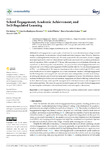Mostrar o rexistro simple do ítem
School Engagement, Academic Achievement, and Self-Regulated Learning
| dc.contributor.author | Estévez, Iris | |
| dc.contributor.author | Rodríguez-Llorente, Carolina | |
| dc.contributor.author | Piñeiro, Isabel | |
| dc.contributor.author | González-Suárez, Rocío | |
| dc.contributor.author | Valle, Antonio | |
| dc.date.accessioned | 2021-04-13T07:35:48Z | |
| dc.date.available | 2021-04-13T07:35:48Z | |
| dc.date.issued | 2021 | |
| dc.identifier.citation | Estévez, I.; Rodríguez-Llorente, C.; Piñeiro, I.; González-Suárez, R.; Valle, A. School Engagement, Academic Achievement,and Self-Regulated Learning. Sustainability 2021, 13, 3011. https://doi.org/10.3390/su13063011 | es_ES |
| dc.identifier.issn | 2071-1050 | |
| dc.identifier.uri | http://hdl.handle.net/2183/27723 | |
| dc.description.abstract | [Abstract] School engagement occupies a place of reference in recent educational psychology research owing to its potential to address poor school results and school dropout rates. However, there is a need for a unifying theoretical framework. The study proposed the characterization of school engagement and explored the extent to which different profiles are associated with academic performance and self-regulation. With a sample of 717 5th and 6th year primary school students, this study was carried out via the latent profile analysis (LPA). Two groups of low school engaged students—one characterized by low behavioral engagement (5.02%) and the other by low emotional engagement (6.55%)—were distinguished. The majority of participants showed moderately high (31.95%) or moderate (56.48%) levels of school engagement in its three dimensions. Students with high engagement had the best grades and managed their time and study surroundings better, were the most strategic in seeking information, and showed less maladaptive regulatory behavior. The differences between students exhibiting low behavioral and emotional engagement and those exhibiting moderate levels in these dimensions may center upon the management of contextual resources and management of information and help. This research supports the need to approach the study of school engagement by observing the combination of its emotional, behavioral, and cognitive dimensions. | es_ES |
| dc.description.sponsorship | This study was performed thanks to financing from research project EDU2013-44062-P (MINECO) and EDU2017-82984-P (MEIC). | es_ES |
| dc.language.iso | eng | es_ES |
| dc.relation | info:eu-repo/grantAgreement/MINECO/Plan Estatal de Investigación Científica y Técnica y de Innovación 2013-2016/EDU2013-44062-P/ES/RELACION ENTRE DEBERES ESCOLARES Y RENDIMIENTO ACADEMICO: UNA PERSPECTIVA MULTINIVEL Y LONGITUDINAL | |
| dc.relation | info:eu-repo/grantAgreement/AEI/Plan Estatal de Investigación Científica y Técnica y de Innovación 2017-2020/EDU2017-82984-P/ES/CALIDAD Y EQUIDAD EN LA PRESCRIPCION DE DEBERES ESCOLARES: DISEÑO E IMPLEMENTACION DE PROPUESTAS BASADAS EN EVIDENCIAS EMPIRICAS | |
| dc.relation.uri | https://doi.org/10.3390/su13063011 | es_ES |
| dc.rights | Atribución 4.0 Internacional | es_ES |
| dc.rights.uri | http://creativecommons.org/licenses/by/4.0/ | * |
| dc.subject | School engagement | es_ES |
| dc.subject | Self-regulated learning | es_ES |
| dc.subject | Academic achievement | es_ES |
| dc.subject | Person-centered approach | es_ES |
| dc.subject | Primary education | es_ES |
| dc.subject | Sustainable development | es_ES |
| dc.title | School Engagement, Academic Achievement, and Self-Regulated Learning | es_ES |
| dc.type | info:eu-repo/semantics/article | es_ES |
| dc.rights.access | info:eu-repo/semantics/openAccess | es_ES |
| UDC.journalTitle | Sustainability | es_ES |
| UDC.volume | 13 | es_ES |
| UDC.startPage | 3011 | es_ES |
| dc.identifier.doi | 10.3390/su13063011 |
Ficheiros no ítem
Este ítem aparece na(s) seguinte(s) colección(s)
-
GI-EIRA - Artigos [30]
-
GI-GIPED - Artigos [57]






